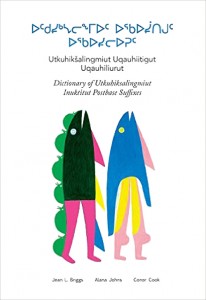Generations ago, most Canadian Inuit lived in small seasonal camps. However, over the past 60 years, Inuit have settled into permanent towns, where traditional dialects intermingled and sometimes developed in to new converged dialects.
One such traditional dialect is Utkuhiksalingmiut — now spoken mainly by elders in the Uqsuqtuuq (Gjoa Haven) and Qamani’tuaq (Baker Lake) communities.
The first dictionary to document this dialect was recently published by Nunavut Arctic College and is entitled Utkuhiksalingmiut Uqauhiitigut: Dictionary of Utkuhiksalingmiut Inuktitut Postbase Suffixes. The 700-plus page book, which was recently recognized by the Minister of Education of Nunavut in the legislature, expounds the numerous suffixes used to form complex words in Inuktitut.
Alana Johns, a professor of linguistics and the former director of the Aboriginal studies program and the Centre for Aboriginal Initiatives in the Faculty of Arts & Science, co-authored the work with Conor Cook and Jean Briggs, an internationally renowned anthropologist.
Arts & Science News spoke with Johns about the dictionary and its importance.
How and why did you get involved as a co-author of this dictionary?
Jean Briggs speaks Inuktitut quite fluently, but is not trained as a linguist. She had many years’ worth of valuable, carefully collected data that she wanted to organize into a dictionary format. She needed a linguist to help with this work, so I was delighted for the opportunity to collaborate with her.
Conor Cook, a former U of T linguistics student now working at the Inuit Uqausinginnik Taiguusiliuqtiit(Inuit Language Authority) in Iqaluit, did the bulk of the actual organization and the dictionary could not have been completed without him.
It was your idea to create a dictionary of postbases. What exactly is a postbase?
Postbases are pieces inside complex words. In the Inuit language, single words range from being very simple to as complex as an entire English sentence. Fluency in the language entails using multiple postbases, sometimes as many as six, inside a word.
Many of the examples in the dictionary are from Jean Briggs’ painstaking fieldwork with Utkuhiksalingmiut speakers in real-life situations, not merely examples that were constructed to illustrate the use of the postbase.
Utkuhiksalingmiut is a dialect of Inuktitut now spoken mainly by elders in the Uqsuqtuuq (Gjoa Haven) and Qamani’tuaq (Baker Lake) communities of Nunavut. How does the publication of this dictionary help to promote and preserve the dialect?
We hope that by providing a detailed analysis of the dialect’s postbases — using as little technical linguistic terminology as possible and by providing numerous examples — fluent younger speakers will be able to expand their proficiency in the language.
The dictionary can also help language teachers create lessons. Hopefully, speakers of other dialects will see the value in researching postbases and perhaps model something similar.
This project documents the richness of the Utkuhiksalingmiut dialect for future generations, as well. How were the elders involved in the project?
The elders were involved since the beginning — well before they were elders.
Jean Briggs first collected this data by living on the land — not in a permanently settled community — with the Utkuhiksalingmiut, in the Back River area of Nunavut.
As she was learning to speak the language, she wrote down words, but also asked about the meanings of the words. Her adopted family and many others were extremely helpful by explaining words and giving further examples, illustrating the use either of word roots (bases) or postbases.
In later years, Jean Briggs went back to visit speakers, who no longer lived on the land but had moved into the settled communities of Gjoa Haven and Baker Lake. She gained further insight into the words through checking her notes and adding to them with the help of speakers.
How do Aboriginal languages serve as modern day links to the history and culture of the people that speak them? What role do dictionaries play?
This is not an easy question for a non-Aboriginal person to answer, but the languages contain expressions for cultural objects and concepts that have not always been translated to English, or the English translation may not carry details inherent to the original word.
Each language also has specific grammatical distinctions and even modes of interaction between individuals. Speaking another language is more than just using other words — it is inhabiting or donning a whole culture.
Generational knowledge and wisdom are transmitted through extended family and social interaction. Indigenous people rely primarily on oral and direct transmission. Dictionaries are just one language resource, but an important one. They do not aim to be an arbiter of language, but can foster understanding and discussion of language and document its richness.
The cover of the dictionary is spectacular. Who’s the artist?

It’s a drawing by the late Jessie Oonark, a very famous Canadian artist whose artwork is part of the National Gallery of Canada’s collection. Being one of the many Inuit artists from the Back River area, she was a speaker of the Utkuhiksalingmiut dialect.

